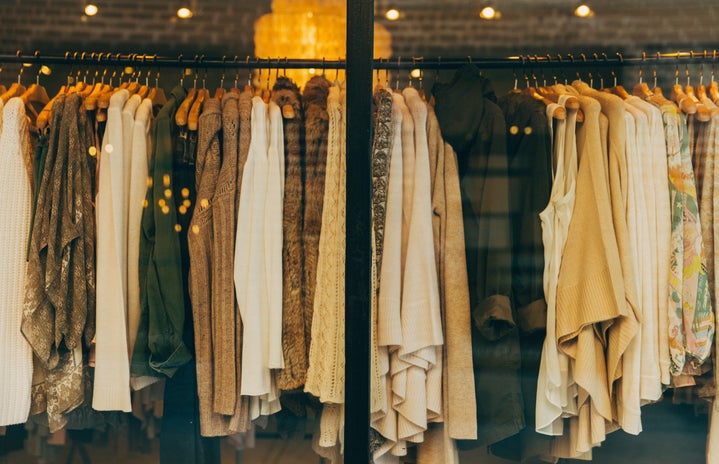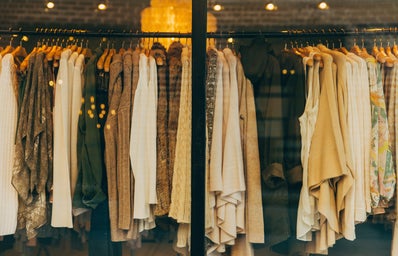Trigger Warning: discussion of eating disorders.
The year is 2012. It is your first day of school. You come to school wearing Justice head to toe like an absolute baddie. But for some reason, the bright, colorful clothing that you have grown to love is absent from the hallways. Instead, girls are wearing the same 3 clothing pieces like NPCs in a video game. You will soon find out that these clothing items are all from Brandy Melville and for some unknown reason 10 years later, we are still obsessed with this store.
Brandy Melville was founded in 1970 by Italian designer Silvio Marsan. While the brand did not gain much popularity in Europe, its first American store opened in California in 2009 and became an overnight hit. Its affordable clothing, muted color palette and teen-target audience made the brand destined for success. But under the surface of this fashion success story lies murky controversies.
While Brandy Melville has had a history with racism, using sweatshops to produce clothing, and perpetuating a general “mean girl” persona, we are going to focus on its “one-size-fits-most” clothing sizing. The clothing at Brandy Melville is designed to fit people with a 25-inch waist and a 32-inch bust. Just to get some perspective, Body Visualizer predicts that someone who is 5’3 with these proportions would have a BMI of 19.5 and someone who is 5’7 would have a BMI of 18.3, both of which border on underweight and normal weight.
A rebuttal to this argument is always, “but there are clothing stores designed for people with larger bodies, why can’t skinny people have their own store?” To that I say: tell me the last time you saw someone on Tik Tok sharing their Torrid haul. Skinny bodies are inherently idealized and as someone who has lived most of their life with thin privilege, there is no need for an exclusively skinny person store. There is a difference between trying to wear a clothing item that is too big for you and trying to wear a clothing item that is too small for you.
As a thin person, I know that I can go into any store and find clothing that will fit me. Even if it’s a little too big, all I would need to do is tailor it or wear a belt. But when you are larger, you physically cannot wear clothing that is too small for you. The necessity for clothing stores for larger bodies is greater than the necessity for clothing stores for smaller bodies.
Now for a more personal story, I would like to outline my journey as a teenager with thin privilege and how as I naturally went through puberty, Brandy Melville negatively impacted my body image. Growing up, I was tall and skinny. For the most part, I hovered around a size 0 or 2. And of course, I was a connoisseur of Brandy Melville clothing. Between the ages of 13 and 16, all of my closets consisted of the low-rise jeans and crop tops of Brandy Melville. That was until one time when I went to Brandy Melville and tried on a pair of pants. I tried to zip them up, but they wouldn’t budge. Tears welled into my eyes. All I could think is “I’m fat, I’m fat, I’m fat.”
Soon after, I had to get rid of most of my Brandy clothes because I could not physically fit into them. To clarify: I may have exhibited eating disorder symptoms, but I do not believe that I have a full-blown eating disorder. But I can absolutely see how someone who already had an eating disorder could have the same experience and start down a dark spiral. Until recently, I had such low self-esteem as it pertained to my body. I hated my thick thighs, broad shoulders, and stomach that did not allow me to fit into the clothing that the desirable girls online wore. A lot of this self-resentment arose from clothing companies like Brandy Melville’s exclusivity.
But I am not the only one with a story like this. On a Pro Ana Reddit page (please browse at your own discretion. A lot of the content can be triggering to people who are recovering from an eating disorder), several posters shared how “fitting into brandy was one of (their) biggest ED goals.” By glorifying thinness, (thinness that may not be healthy or even possible to some people) we are worsening the disorders of people who already suffer from ED’s and leading people who previously did not suffer from eating disorders to adopt disordered behavior.
But what can we do to undo the damage that this brand has caused? For one, we can boycott Brandy Melville. Even if you do fit into their clothes, you are still supporting a fatphobic and racist brand. When we actively stop supporting a brand, its popularity will decrease and in turn, its desirability will decrease as well. But if you really want to shop brands with a similar aesthetic as Brandy Melville, you can find dupes in this article from StyleCaster. Another thing that you can do is simply start a dialogue about how “one-size-fits-all” brands are harmful and encourage people to stop shopping for this brand. When we start conversations around these topics and brands see their profit margins decreasing, they are more willing to make changes for the better.

